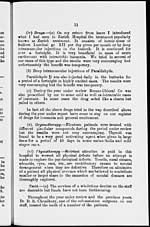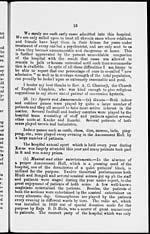Medicine - Mental health > 1930-1940 - Report on the working of the Ranchi Indian Mental Hospital, Kanke, in Bihar and Orissa > Annual report on the working of the Ranchi Indian Mental Hospital, Kanke in Bihar and Orissa for the year 1930
(22) Page 12
Download files
Individual page:
Thumbnail gallery: Grid view | List view

12
(b) Similarly, Dr. P. C. Das, M.B., who is happily also an
eye specialist, did excellent work with ophthalmoscope and
operated on some cases of cataract among the patients,
(c) Syphilis.—During the year under report, 425 blood
specimens were sent to the Pathological Laboratory of the
Prince of Wales Medical College, Patna, for Wasserman test
and suitable anti-syphilitic treatment was given to positive cases.
(d) Leprosy.—During the year under review we were
obliged to treat three highly-contagious positive cases of leprosy
in the hospital as those cases were not admitted in the Albert
Victor Leper Hospital, Gobra (Calcutta), for want of accommoda-
tion. This is admittedly a serious state of affairs which would
be remedied if the Government of Bengal could arrange to reserve
a few beds for this hospital in the Albert Victor Leper Hospital
at Gobra for the treatment of such acute cases. To treat highly-
contagious leper cases in mental hospital is undesirable for
obvious reasons.
(vii) Malarial therapy.—During the year under review four
patients were given malarial therapy with indifferent results.
(viii)—Sulfosin therapy.—On my return from leave during
the latter part of the year under report I have injected a few
selected cases with sulfosin (which is 1 per cent. solution or
suspension of sulphur in olive oil). Dr. Knud Schrœdor, an
eminent physician of Denmark, in 1929 claimed to produce
pyrexia by injections of sulphur in olive oil better than that
produced by malarial therapy. So far we agree with his claim
as our patients have shown a steady rise of temperature up to
103 degrees after every injection. The results of our experiments
will be fully given in our next annual report as at the time of
writing this report the treatment is still under trial and not yet
completed.
(ix). Psychotherapy.—A case was admitted from Calcutta
as a case of complete paralysis of both legs with mental excite-
ment. The patient was brought into the hospital on a stretcher.
On examination the cas3 was diagnosed as a case of " con-
version hysteria " and the patient, who was treated as a case
of paralysis of the legs for three months outside, was made to
walk within eight days of his admission and was discharged
cured within two months, and he went to Goa—his native
place—which is a distance of 1,500 miles from Ranchi on
his own.
Set display mode to: Large image | Zoom image | Transcription
Images and transcriptions on this page, including medium image downloads, may be used under the Creative Commons Attribution 4.0 International Licence unless otherwise stated. ![]()
| Permanent URL | https://digital.nls.uk/83973262 |
|---|




